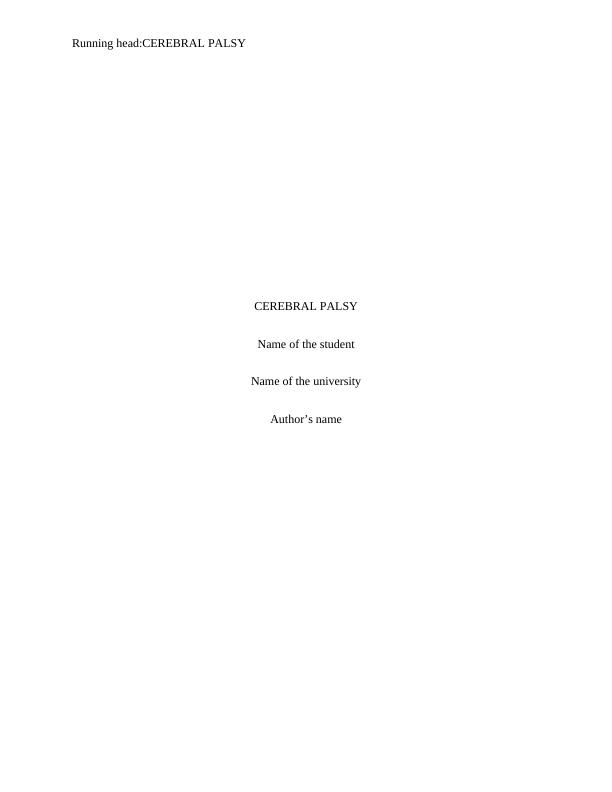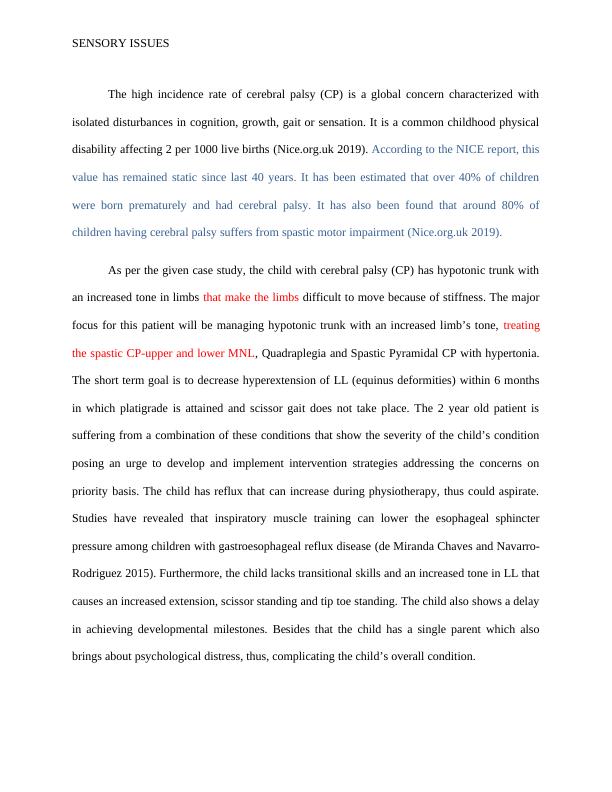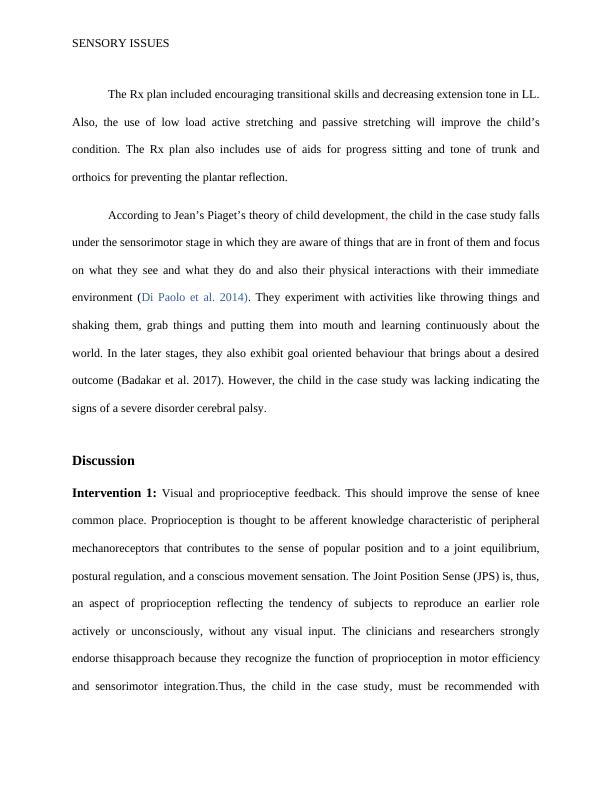Sensory Issues - Cerebral Palsy
The assignment is about addressing tone, positioning, and transition skills in a child with cerebral palsy (CP) through hands-on treatment.
15 Pages3926 Words18 Views
Added on 2022-08-18
Sensory Issues - Cerebral Palsy
The assignment is about addressing tone, positioning, and transition skills in a child with cerebral palsy (CP) through hands-on treatment.
Added on 2022-08-18
ShareRelated Documents
Running head:CEREBRAL PALSY
CEREBRAL PALSY
Name of the student
Name of the university
Author’s name
CEREBRAL PALSY
Name of the student
Name of the university
Author’s name

SENSORY ISSUES
The high incidence rate of cerebral palsy (CP) is a global concern characterized with
isolated disturbances in cognition, growth, gait or sensation. It is a common childhood physical
disability affecting 2 per 1000 live births (Nice.org.uk 2019). According to the NICE report, this
value has remained static since last 40 years. It has been estimated that over 40% of children
were born prematurely and had cerebral palsy. It has also been found that around 80% of
children having cerebral palsy suffers from spastic motor impairment (Nice.org.uk 2019).
As per the given case study, the child with cerebral palsy (CP) has hypotonic trunk with
an increased tone in limbs that make the limbs difficult to move because of stiffness. The major
focus for this patient will be managing hypotonic trunk with an increased limb’s tone, treating
the spastic CP-upper and lower MNL, Quadraplegia and Spastic Pyramidal CP with hypertonia.
The short term goal is to decrease hyperextension of LL (equinus deformities) within 6 months
in which platigrade is attained and scissor gait does not take place. The 2 year old patient is
suffering from a combination of these conditions that show the severity of the child’s condition
posing an urge to develop and implement intervention strategies addressing the concerns on
priority basis. The child has reflux that can increase during physiotherapy, thus could aspirate.
Studies have revealed that inspiratory muscle training can lower the esophageal sphincter
pressure among children with gastroesophageal reflux disease (de Miranda Chaves and Navarro-
Rodriguez 2015). Furthermore, the child lacks transitional skills and an increased tone in LL that
causes an increased extension, scissor standing and tip toe standing. The child also shows a delay
in achieving developmental milestones. Besides that the child has a single parent which also
brings about psychological distress, thus, complicating the child’s overall condition.
The high incidence rate of cerebral palsy (CP) is a global concern characterized with
isolated disturbances in cognition, growth, gait or sensation. It is a common childhood physical
disability affecting 2 per 1000 live births (Nice.org.uk 2019). According to the NICE report, this
value has remained static since last 40 years. It has been estimated that over 40% of children
were born prematurely and had cerebral palsy. It has also been found that around 80% of
children having cerebral palsy suffers from spastic motor impairment (Nice.org.uk 2019).
As per the given case study, the child with cerebral palsy (CP) has hypotonic trunk with
an increased tone in limbs that make the limbs difficult to move because of stiffness. The major
focus for this patient will be managing hypotonic trunk with an increased limb’s tone, treating
the spastic CP-upper and lower MNL, Quadraplegia and Spastic Pyramidal CP with hypertonia.
The short term goal is to decrease hyperextension of LL (equinus deformities) within 6 months
in which platigrade is attained and scissor gait does not take place. The 2 year old patient is
suffering from a combination of these conditions that show the severity of the child’s condition
posing an urge to develop and implement intervention strategies addressing the concerns on
priority basis. The child has reflux that can increase during physiotherapy, thus could aspirate.
Studies have revealed that inspiratory muscle training can lower the esophageal sphincter
pressure among children with gastroesophageal reflux disease (de Miranda Chaves and Navarro-
Rodriguez 2015). Furthermore, the child lacks transitional skills and an increased tone in LL that
causes an increased extension, scissor standing and tip toe standing. The child also shows a delay
in achieving developmental milestones. Besides that the child has a single parent which also
brings about psychological distress, thus, complicating the child’s overall condition.

SENSORY ISSUES
The Rx plan included encouraging transitional skills and decreasing extension tone in LL.
Also, the use of low load active stretching and passive stretching will improve the child’s
condition. The Rx plan also includes use of aids for progress sitting and tone of trunk and
orthoics for preventing the plantar reflection.
According to Jean’s Piaget’s theory of child development, the child in the case study falls
under the sensorimotor stage in which they are aware of things that are in front of them and focus
on what they see and what they do and also their physical interactions with their immediate
environment (Di Paolo et al. 2014). They experiment with activities like throwing things and
shaking them, grab things and putting them into mouth and learning continuously about the
world. In the later stages, they also exhibit goal oriented behaviour that brings about a desired
outcome (Badakar et al. 2017). However, the child in the case study was lacking indicating the
signs of a severe disorder cerebral palsy.
Discussion
Intervention 1: Visual and proprioceptive feedback. This should improve the sense of knee
common place. Proprioception is thought to be afferent knowledge characteristic of peripheral
mechanoreceptors that contributes to the sense of popular position and to a joint equilibrium,
postural regulation, and a conscious movement sensation. The Joint Position Sense (JPS) is, thus,
an aspect of proprioception reflecting the tendency of subjects to reproduce an earlier role
actively or unconsciously, without any visual input. The clinicians and researchers strongly
endorse thisapproach because they recognize the function of proprioception in motor efficiency
and sensorimotor integration.Thus, the child in the case study, must be recommended with
The Rx plan included encouraging transitional skills and decreasing extension tone in LL.
Also, the use of low load active stretching and passive stretching will improve the child’s
condition. The Rx plan also includes use of aids for progress sitting and tone of trunk and
orthoics for preventing the plantar reflection.
According to Jean’s Piaget’s theory of child development, the child in the case study falls
under the sensorimotor stage in which they are aware of things that are in front of them and focus
on what they see and what they do and also their physical interactions with their immediate
environment (Di Paolo et al. 2014). They experiment with activities like throwing things and
shaking them, grab things and putting them into mouth and learning continuously about the
world. In the later stages, they also exhibit goal oriented behaviour that brings about a desired
outcome (Badakar et al. 2017). However, the child in the case study was lacking indicating the
signs of a severe disorder cerebral palsy.
Discussion
Intervention 1: Visual and proprioceptive feedback. This should improve the sense of knee
common place. Proprioception is thought to be afferent knowledge characteristic of peripheral
mechanoreceptors that contributes to the sense of popular position and to a joint equilibrium,
postural regulation, and a conscious movement sensation. The Joint Position Sense (JPS) is, thus,
an aspect of proprioception reflecting the tendency of subjects to reproduce an earlier role
actively or unconsciously, without any visual input. The clinicians and researchers strongly
endorse thisapproach because they recognize the function of proprioception in motor efficiency
and sensorimotor integration.Thus, the child in the case study, must be recommended with

SENSORY ISSUES
proprioceptive and visual feedback in order to recover knee joint sensation (Roden-Reynolds et
al. 2015).
Indications: People with acute sensory neuropathy or extreme large-fiber sensory neuropathy
have different degrees of weakness with regard to their proprioceptive feedback, the former
having an almost total lack of proprioception across the body and the latter mostly in specific
places. Also in the lackof proprioceptive feedback, the two samples demonstrated that visual
input of the limb structure is always possible through motion control. If visual and
proprioceptive input is not available, it is still possible to track motion if the initial arm
configuration is recognised. The distorting proprioceptive afferents through muscle vibrations, it
has been established that accurate proprioceptive knowledge of the initial condition of the limb is
essential to position the limb when vision is blocked (Hasson 2017).
Complications: Proprioception is described as the conscious and subconscious awareness of the
mechanical and spatial position of the musculoskeletal framework. While associating with
children suffering from sensory integrative dysfunction and motor delays, occupational therapists
regularly evaluate the child’s proprioceptive system. Nevertheless, at present, the occupational
therapists employ assessments that are mainly observer-based and several concerns have been
found regarding the reliability of such assessments of the sensation. Neck muscles exhibit a
deepermuscle spindle distribution in comparison to the other muscles which can indicate that a
higher level of functions that proprioceptive and are essential for these muscles. Thus, in children
suffering from cerebral palsy, the basis for movement are not provided by the proprioceptive
senses because of a misperception among the senses as a result of postural tension’s abnormal
levels. An increase in tension leads to functional disorders of the muscle spindles in such a way
proprioceptive and visual feedback in order to recover knee joint sensation (Roden-Reynolds et
al. 2015).
Indications: People with acute sensory neuropathy or extreme large-fiber sensory neuropathy
have different degrees of weakness with regard to their proprioceptive feedback, the former
having an almost total lack of proprioception across the body and the latter mostly in specific
places. Also in the lackof proprioceptive feedback, the two samples demonstrated that visual
input of the limb structure is always possible through motion control. If visual and
proprioceptive input is not available, it is still possible to track motion if the initial arm
configuration is recognised. The distorting proprioceptive afferents through muscle vibrations, it
has been established that accurate proprioceptive knowledge of the initial condition of the limb is
essential to position the limb when vision is blocked (Hasson 2017).
Complications: Proprioception is described as the conscious and subconscious awareness of the
mechanical and spatial position of the musculoskeletal framework. While associating with
children suffering from sensory integrative dysfunction and motor delays, occupational therapists
regularly evaluate the child’s proprioceptive system. Nevertheless, at present, the occupational
therapists employ assessments that are mainly observer-based and several concerns have been
found regarding the reliability of such assessments of the sensation. Neck muscles exhibit a
deepermuscle spindle distribution in comparison to the other muscles which can indicate that a
higher level of functions that proprioceptive and are essential for these muscles. Thus, in children
suffering from cerebral palsy, the basis for movement are not provided by the proprioceptive
senses because of a misperception among the senses as a result of postural tension’s abnormal
levels. An increase in tension leads to functional disorders of the muscle spindles in such a way

End of preview
Want to access all the pages? Upload your documents or become a member.
